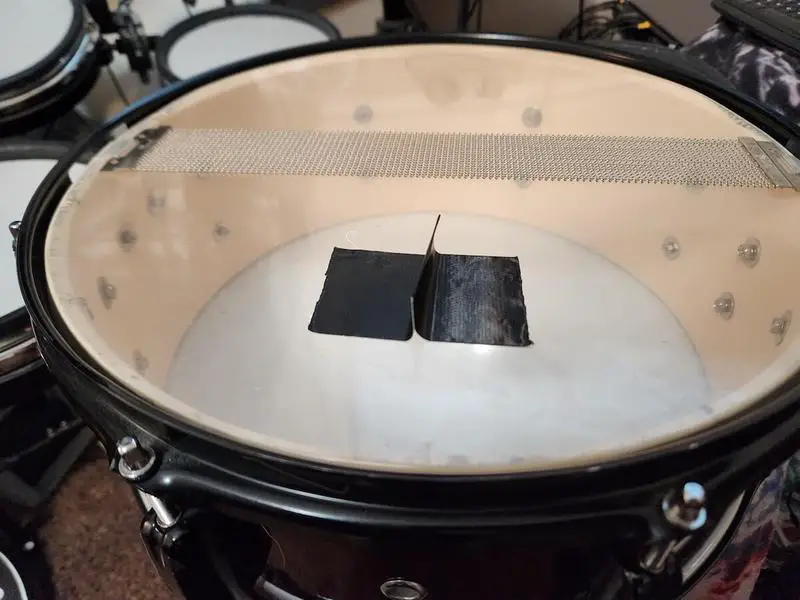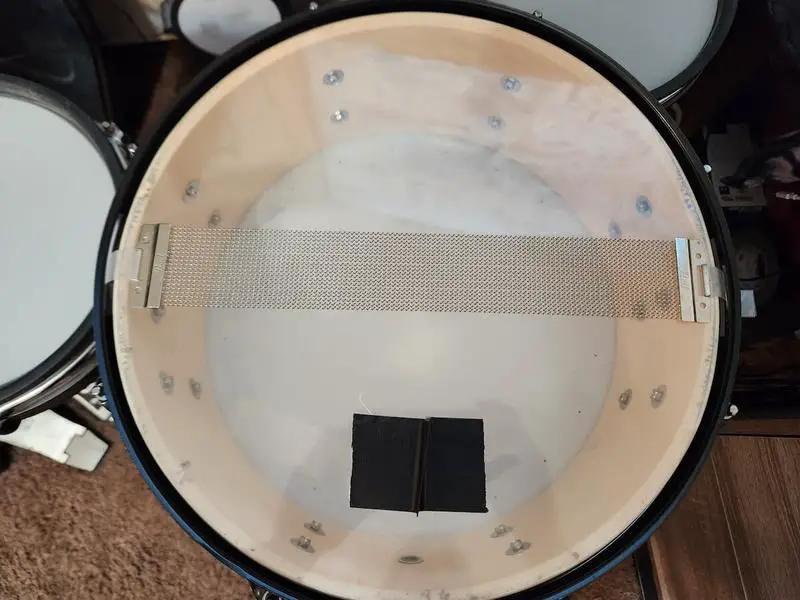How To Stop Drums Ringing And Getting A Tight, Controlled Sound


We as drummers have all heard it.
It often gives the same emotion as nails on the chalkboard.
You strike your drumhead and the sound you hear is not the full, rich resonance that you were expecting. Instead, you hear a high-pitched tone that causes your breath to catch, and all your bandmates to stop and give you the look that begs the question, “was that intentional?”
I’ve been given that look, oh, trust me, I’ve been embarrassed due to the soprano tone that’s emanating from my rack tom, the tom that’s supposed to sing out in tenor.
I’ve had that unexpected ringing in every single acoustic set I’ve ever owned, and I’ve adjusted them away from every piece on a kit, be it floor tom, rack tom, open shell (roto) tom, or snare.
On second thought, I don’t recall ever having had a bass drum singing out of tune with a ring. Sturdy little workhorses.
It’s not impossible, though, and I’ll tell you why as I explain different methods I’ve tried that help to eliminate that ringing drum.
Table of Contents
So why do drums ring anyway?
So, what’s the answer?
How do you make the unexpected ringing sound disappear?
That’s the second question to ask, preceded by, why is my drum ringing?
The most common answer, the most common reason for this ring is clashing resonance; a high-pitched sound wave that’s usually caused by the resonant head of the ringing drum.
It’s most often caused when the vibration of the resonant head and the vibration of the batter head are tensioned such that they vibrate complimentary to one another, and this creates that ringing sound. I know, “clashing” and “complimentary” seem a bit of an oxymoron, but we all know that ring, it is such a clash too.
So, quite simply, to end the ringing, you must adjust the vibrations coming from the heads.
This is accomplished in a variety of ways.
Follow along, I’m going to discuss some of my tried-and-true methods, and I’ll offer suggestions for those I’ve not yet tried as well.
First method - adjusting the drumhead tension
First, try adjusting your drumhead tension.
Your drum, whether it’s a snare, tom, bass, or even a hollowed-out log with deer pelts stretched across, is a machine, of sorts. I’m not talking the traditional machine like we imagine from the industrial revolution.
This machine moves and manipulates air. With adjustments in tensioning of the head(s), you adjust how much and how fast air will be disrupted by the vibrations of the drumhead(s). This is the reason the sound becomes higher or lower based on how tight your drumhead is. It’s also the reason you can “tune” your drums to a specific pitch range.
You can adjust the wavelength produced by striking the batter head, by adjusting tension in one or both heads.
The reason for saying all of this is that by simply adjusting a drumhead, you can sometimes eliminate the ringing. The “complimentary” overtone will go away as the wavelengths of the two heads de-synchronize.
Therefore, adjusting the tension of your drums is usually your best answer.
You shouldn’t need to adjust very much either, I have often eliminated the ringing by giving each lug a quarter turn. You will need to test your situation if you need to turn clockwise or counterclockwise, however in my experience the ringing comes from over and not under tensioning.
Second method – try a different drumhead
Drumheads are not all made the same!
There are myriad drumhead designs. Speaking solely of batter heads, you’ll find tons of options. There is single ply, double ply, coated heads, heads with a center circle laminated on, coated center heads with clear edges, and one of my favorites, hydraulic heads from Evans.
Each of these designs has characteristics that you may or may not like regarding the final sound. A lighter head, for instance a single ply head, will have more flexibility and allow a longer sustain. Therefore, resonate heads are most often constructed of a single ply without any coating. This isn’t always the case, but generally speaking, you can safely guess it to be the case.
Unless you have a custom drum set constructed, anyone you buy out of the box will have single ply resonate heads. We will be going over a couple of things to try with the resonant head in the next section, so for now, I will be speaking strictly about the batter head.
The batter head, vibrates with the strongest frequency, and for obvious reasons. It needs to be durable as well as flexible, so manufacturers have discovered various ways to create batter heads for different playing situations.
Jazz drumming is fast and light with some medium-heavy strikes coming from the player. The heads for a jazz centered set are going to be thin and have a quick response with a good sustain.
Modern rock is heavy and more driving, using steady and heavy strikes for its tones, and therefore don’t require quite as responsive of heads, yet will need to control the resonance with slightly less tolerance for vibration.
Here is where you are going to see those hydraulic heads I love so much – hydraulic heads. Yup, hydraulic suggests oil. These heads have two plies with a thin layer of oil between them, and they are dampening kings! I have hydraulic heads on my personal kit.
The oil acts as a shock absorber and displaces the attack to the surrounding area. It also acts to absorb, or dampen, sympathetic frequencies from the resonant head, as well as noises from the room the kit is set up in.
Third method – dampening your drums
So, adjusting tension isn’t the answer you need?
Maybe you’re playing on a borrowed drum set and it would be distasteful to adjust someone else’s tuning, or it’s ten minutes before showtime and you’ve only just discovered the ring (room acoustics can do this you know).
For whatever reason, tuning the skins on the shells isn’t going to be the right answer, and/or you can’t put a different drumhead on… not to fret, you can “dampen,” or absorb soundwaves by mechanical means.
This is my last resort, and you should make it yours too.
Dampeners come in many forms, from the “life hack” all the way to professionally designed pads for acoustic kits during practice, and there is any number of options between.
The most common products are probably circle mufflers or gel-like pads that in theory stick to the resonant head, but in application, usually fail. For me to have any success with a gel, it has had to be placed on the batter head. I haven’t gone back to a gel.
My go to?
I like gaffer tape.
If you don’t know what that is, let’s just say it’s a duct tape made of more fibrous material.
I like to get a piece of the tape that’s around 3-4 inches long, and I make a crease in the center, folding the sticky to itself, I fold half an inch to an inch (depending on how bad the ring is), and then I stick the rest of the tape flat on the underside of the resonant head.
It looks like a flat shark fin sticking out of the drum (see images below) and that fin is a sound dampener, it absorbs vibration from the resonant head.




Some people stick a coin between the shark fin for weight, but I’ve just never had a ring that bad. I laugh when I think, “I wonder how bad a ring would require a ‘AA’ battery in the fin?”.
Keep this in mind
There are times when combining these efforts can produce the best result.
If you’ve found the exact sound you like, the sweet spot, and there is still a slight ringing, try adding a small patch of the gaffer tape, try a small chunk of the gel on the batter head, there is no wrong combination.
Experiment around until you get your sound dialed in perfectly.
Conclusion
It is important to note that rooms with poor acoustics, or guitar chords at the right pitch, can cause that awful ring, so if you have tried these ways I’ve just covered, and you still get that ringing sound, there could be an outside influence.
Could be, yes.
Most of the time, however, you’ve merely put your resonant and batter heads into a tension that complement each other in their soundwaves and cause an overtone that’s not wanted. In this case, the best way to rid the ringing is to slightly adjust your batter drumhead on the ringing drum, and possibly combine with a dampening product for your dialed in sound.
Who we are
AboutDrumming.com is run by a group of drum teachers, drumming professionals and hobbyists. We love all things drums, and when not drumming we spend our time adding more awesome content to this website!
Free tools
You may also like
- Coated Vs Clear Drumheads - The Ultimate Guide
- Drums Too Loud When Practicing? Here's What You Can Do
- Do Drummers Have To Tune Like Other Musicians?
Affiliate Disclosure: When relevant AboutDrumming.com uses affiliate links (at no additional cost to you). As an Amazon Associate I earn from qualifying purchases.